Press Room
Scientists from the Woods Hole Oceanographic Institution (WHOI) have conducted a new study to measure levels of carbon at various depths in the Arctic Ocean. The study, recently published in the journal Biogeosciences, provides data that will help researchers better…
Severe droughts, floods, and storms are now a routine part of our nation’s weather forecast. Remarkably hot and dry weather in 2011 caused droughts in Texas, the Plains states and the West. The year also brought historic flooding along the…
Scientists have predicted that ocean temperatures will rise in the equatorial Pacific by the end of the century, wreaking havoc on coral reef ecosystems. But a new study shows that climate change could cause ocean currents to operate in a surprising way and mitigate the warming near a handful of islands right on the equator. As a result these Pacific islands may become isolated refuges for corals and fish.
For decades, scientists have known that dolphins and other toothed whales have specialized fats associated with their jaws, which efficiently convey sound waves from the ocean to their ears. But until now, the hearing systems of their toothless grazing cousins, baleen whales, remained a mystery, largely because specimens to study are hard to get. Now, a new study by scientists at Woods Hole Oceanographic Institution has shown that some baleen whales also have fats leading to their ears.
New England is expected to experience a “moderate” regional “red tide” this spring and summer, report NOAA-funded scientists working in the Gulf of Maine to study the toxic algae that causes the bloom. The algae in the water pose no direct threat to human beings, however the toxins they produce can accumulate in filter-feeding organisms such as mussels and clams— which can cause paralytic shellfish poisoning (PSP) in humans who consume them.
An international research team is reporting the results of a research cruise they organized to study the amount, spread, and impacts of radiation released into the ocean from the tsunami-crippled reactors in Fukushima, Japan. The group of 17 researchers and…
Newly released images of the Titanic wreck site provide the first unrestricted view of the world’s most notable maritime heritage site. These new images add to the already unprecedented collection of images published in the April 2012 issue of National…
Scientists from the Woods Hole Oceanographic Institution (WHOI), University of Hawaii, Whitman College and international colleagues will conduct the first systematic study of life in the deepest marine habitat on Earth—ocean trenches. Due to the extreme pressures of these deep-sea…
Six scientists from Woods Hole Oceanographic Institution (WHOI) have contributed to a new report finding “compelling evidence” that the Deepwater Horizon oil spill has impacted deep-sea coral communities in the Gulf of Mexico. The study, published the week of March…
Increased global temperatures are frequently viewed as the cause of glacial melt, but a new study of Patagonia’s Gualas Glacier highlights the role of precipitation in the glacier’s fluctuation. The study, conducted by Sbastien Bertrand of the Woods Hole Oceanographic Institution (WHOI) and his colleagues, compares past temperature and rainfall data with sediment records of glacier fluctuations and the historical observations of early Spanish explorers.
A fundamental shift in the Indian monsoon has occurred over the last few millennia, from a steady humid monsoon that favored lush vegetation to extended periods of drought, reports a new study led by researchers at the Woods Hole Oceanographic Institution (WHOI). The study has implications for our understanding of the monsoon’s response to climate change.
The March 11, 2011, earthquake, tsunami, and subsequent radioactivity releases from the Fukushima Dai-ichi nuclear power plants resulted in the largest accidental release of radiation to the ocean in history. In a special session on Tuesday, Feb. 21, during the…
Jim Yoder Named 2012 fellow of The Oceanography Society Jim Yoder, Vice President for Academic Programs and Dean at the Woods Hole Oceanographic Institution (WHOI), has been named a 2012 fellow of The Oceanography Society (TOS)—the only fellow named this…
One of the most dangerous faults in North America is the Pacific Northwest’s Cascadia fault – an offshore, subduction zone fault capable of producing a magnitude 9 earthquake that would damage Portland, Tacoma, Seattle, and Victoria, British Columbia, and generate a large tsunami. Yet there are currently no instruments installed offshore, directly above the fault, for measuring the strain that is currently building up along the fault.
But a recent $1 million grant from The W. M. Keck Foundation to scientists at the Woods Hole Oceanographic Institution (WHOI) will change that. An interdisciplinary project led by WHOI geologist Jeff McGuire, an expert in global earthquake seismology and geodesy, and John Collins, director of WHOI’s Ocean Bottom Seismometer Lab, will build and install the first seafloor geodesy observatory above the expected rupture zone of the next great Cascadia earthquake.
Woods Hole Oceanographic Institution Senior Scientists Lloyd Keigwin and Robert Weller have been elected 2012 fellows of the American Association for the Advancement of Science (AAAS). Election as a fellow is an honor bestowed upon AAAS members by their peers.…
The National Academy of Sciences (NAS) has awarded John Waterbury, scientist emeritus in the Biology Department at the Woods Hole Oceanographic Institution (WHOI), the 2012 Gilbert Morgan Smith Medal. Waterbury is among 17 individuals honored by NAS this year in…
Shortly after the Deepwater Horizon disaster, mysterious honeycomb material was found floating in the Gulf of Mexico and along coastal beaches. Using state-of-the-art chemical forensics and a bit of old-fashioned detective work, a research team led by scientists at Woods…
Louis St. Laurent of the Woods Hole Oceanographic Institution (WHOI) was selected by the American Meteorological Society (AMS) to receive the prestigious Nicholas P. Fofonoff Award. There will be a formal presentation at the Annual Awards Banquet on January 25,…
A new study provides a composite picture of the environmental distribution of oil and gas from the 2010 Deepwater Horizon spill in the Gulf of Mexico. It amasses a vast collection of available atmospheric, surface and subsurface chemical data to…
How do marine mammals, whose very survival depends on regular diving, manage to avoid decompression sickness? Do they, indeed, avoid it? A workshop held by WHOI’s Marine Mammal Center brought together the world’s experts in human diving and marine-mammal diving physiology to discuss the issue of how marine mammals manage gas under pressure.




